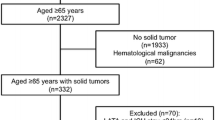Abstract
Although more palliative care is necessary for terminally ill cancer patients, excess investigational tests, invasive procedures, and treatments are given instead. Between November 2009 and December 2013, six hundred and twenty-four patients with end-stage cancer who were died at inpatient setting evaluated retrospectively. Patients’ characteristics, sites of tumor and metastasis, tests and invasive procedures, treatments performed in the last 2 weeks before death were collected from the hospital files and analyzed. Median age of 624 patients was 58 (range 16–96) years. More than half of the patients (370, 59.3 %) were men. The most frequent cancer sites were gastrointestinal (GI) system (32.2 %), lung (24.0 %), and breast (11.1 %). Frequent metastatic sites were liver (34.8 %), bone (31.5 %), lung (23.3 %), and/or brain (16.9 %). Causes of death were respiratory failure, infections, and/or liver failure in 49.9, 23.9, and 19.4 % of patients, respectively. Radiological tests performed in the last 2 weeks before death were ultrasonography, computed tomography, magnetic resonance imaging, bone scan in 25.6, 16.3, 11.4, and 3.8 % of patients, respectively. Treatments received were intravenous (i.v) serum infusion, blood transfusion, total parenteral nutrition (TPN), human albumin infusion in 55.9, 44.1, 34.9, and 9.5 % of patients, respectively. Invasive procedures such as invasive pain relief, terminal sedation, and chemotherapy performed in 12.6, 4.4, and 10.0 % of patients, respectively. Central venous catheter application, paracentesis, thoracentesis, and GI endoscopy were applied in 41.7, 9.8, 5.6, and 3.4 % of the patients, respectively. Radiological tests, invasive procedures, TPN, and human albumin transfusion were used excessively in terminal stage cancer patients in our medical oncology inpatient clinics. Invasive pain relief and terminal sedation were still underused in our cancer clinics. There is an urgent need in developing national palliative care program to improve the understanding of end-of-life care in our medical oncology clinics.
Similar content being viewed by others
References
Smith TJ, Temin S, Alesi ER, Abernethy AP, Balboni TA, Basch EM, et al. American society of clinical oncology provisional clinical opinion: the integration of palliative care into standard oncology care. J Clin Oncol. 2012;30:880–7. http://www.ncbi.nlm.nih.gov/pubmed/22312101.
Temel JS, Greer JA, Muzikansky A, Gallagher ER, Admane S, Jackson VA, et al. Early palliative care for patients with metastatic non-small-cell lung cancer. N Engl J Med. 2010;363:733–42. http://www.ncbi.nlm.nih.gov/pubmed/20818875.
Temel JS, Greer JA, Admane S, Gallagher ER, Jackson VA, Lynch TJ, et al. Longitudinal perceptions of prognosis and goals of therapy in patients with metastatic non-small-cell lung cancer: results of a randomized study of early palliative care. J Clin Oncol. 2011;29:2319–26. http://www.ncbi.nlm.nih.gov/pubmed/21555700.
Glare P, Virik K, Jones M, Hudson M, Eychmuller S, Simes J, et al. A systematic review of physicians’ survival predictions in terminally ill cancer patients. BMJ. 2003;327:195–8. http://www.pubmedcentral.nih.gov/articlerender.fcgi?artid=166124&tool=pmcentrez&rendertype=abstract.
Maltoni M, Caraceni A, Brunelli C, Broeckaert B, Christakis N, Eychmueller S, et al. Prognostic factors in advanced cancer patients: evidence-based clinical recommendations—a study by the steering committee of the european association for palliative care. J Clin Oncol. 2005;23:6240–8.
Hu W, Yasui Y, White J, Winget M. Aggressiveness of end-of-life care for patients with colorectal cancer in Alberta, Canada: 2006–2009. J Pain Symptom Manage. Elsevier Inc; 2014;47:231–44. http://www.ncbi.nlm.nih.gov/pubmed/23870414.
Mariotto AB, Yabroff KR, Shao Y, Feuer EJ, Brown ML. Projections of the cost of cancer care in the United States: 2010-2020. J Natl Cancer Inst. 2011;103:117–28. http://www.pubmedcentral.nih.gov/articlerender.fcgi?artid=3107566&tool=pmcentrez&rendertype=abstract.
Earle CC, Neville BA, Landrum MB, Ayanian JZ, Block SD, Weeks JC. Trends in the aggressiveness of cancer care near the end of life. J Clin Oncol. 2004;22:315–21. http://www.ncbi.nlm.nih.gov/pubmed/14722041.
Earle CC. Identifying Potential Indicators of the Quality of End-of-Life Cancer Care From Administrative Data. J Clin Oncol. 2003;21:1133–8. http://www.jco.org/cgi/doi/10.1200/JCO.2003.03.059.
Earle CC, Neville BA, Landrum MB, Souza JM, Weeks JC, Block SD, et al. Evaluating claims-based indicators of the intensity of end-of-life cancer care. Int J Qual Health Care. 2005;17:505–9. http://www.ncbi.nlm.nih.gov/pubmed/15985505.
Gaeta S, Price KJ. End-of-life issues in critically ill cancer patients. Crit Care Clin. Elsevier Ltd; 2010;26:219–27. http://www.ncbi.nlm.nih.gov/pubmed/19944283.
Masood UR, Said A, Faris C, Al Mussady M, Al Jundi A. Limiting intensive care therapy in dying critically Ill patients: Experience from a tertiary care center in United Arab Emirates. Int J Crit Illn Inj Sci. 2013;3:200–5. http://www.pubmedcentral.nih.gov/articlerender.fcgi?artid=3883199&tool=pmcentrez&rendertype=abstract.
Teno JM, Gozalo PL, Bynum JPW, Leland NE, Miller SC, Morden NE, et al. Change in end-of-life care for Medicare beneficiaries: site of death, place of care, and health care transitions in 2000, 2005, and 2009. JAMA. 2013;309:470–7. http://www.pubmedcentral.nih.gov/articlerender.fcgi?artid=3674823&tool=pmcentrez&rendertype=abstract.
Rondeau DF, Schmidt TA. Treating cancer patients who are near the end of life in the emergency department. Emerg Med Clin North Am. 2009;27:341–54. http://www.ncbi.nlm.nih.gov/pubmed/19447316.
Hong JH, Rho S-Y, Hong YS. Trends in the Aggressiveness of End-of-Life Care for Advanced Stomach Cancer Patients. Cancer Res Treat. 2013;45:270–5. http://www.ncbi.nlm.nih.gov/pubmed/24453999.
Hui D, Bruera E. Personalizing treatment decisions for cancer patients at the end of life: reply to Soh and Wong. J. Pain Symptom Manage. U.S. Cancer Pain Relief Committee; 2013;45:e4–5. http://www.ncbi.nlm.nih.gov/pubmed/23522519.
Kao S, Shafiq J, Vardy J, Adams D. Use of chemotherapy at end of life in oncology patients. Ann Oncol. 2009;20:1555–9. http://www.ncbi.nlm.nih.gov/pubmed/19468033.
Andreis F, Rizzi A, Rota L, Meriggi F, Mazzocchi M, Zaniboni A. Chemotherapy use at the end of life. A retrospective single centre experience analysis. Tumori. 2011;97:30–4. http://www.ncbi.nlm.nih.gov/pubmed/21528660.
Khan SA, Gomes B, Higginson IJ. End-of-life care–what do cancer patients want? Nat Rev Clin Oncol. 2014;11:100–8. http://www.ncbi.nlm.nih.gov/pubmed/24281062.
Conflict of interest
The authors declare that they have no financial relationship regarding the commercial matters and/or no conflict of interest.
Author information
Authors and Affiliations
Corresponding author
Rights and permissions
About this article
Cite this article
Türker, İ., Kömürcü, Ş., Arıcan, A. et al. Investigational tests and treatments performed in terminal stage cancer patients in two weeks before death: Turkish oncology group (TOG) study. Med Oncol 31, 350 (2014). https://doi.org/10.1007/s12032-014-0350-8
Received:
Accepted:
Published:
DOI: https://doi.org/10.1007/s12032-014-0350-8




